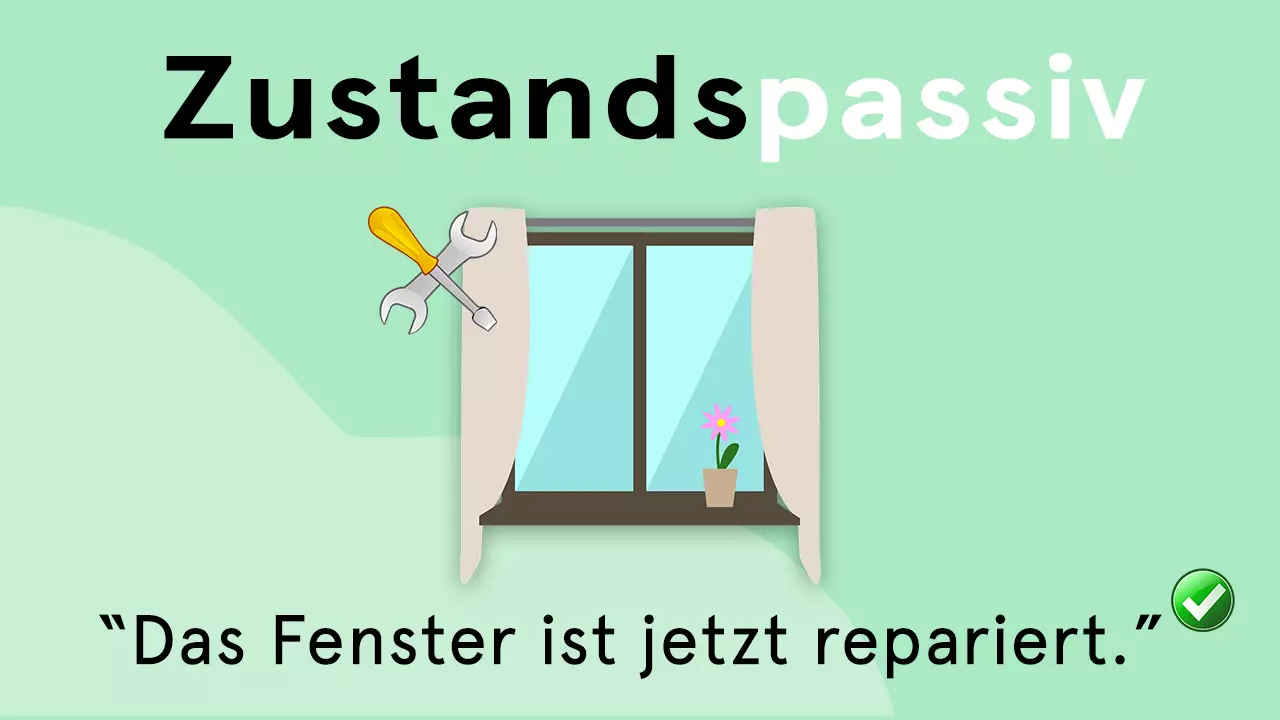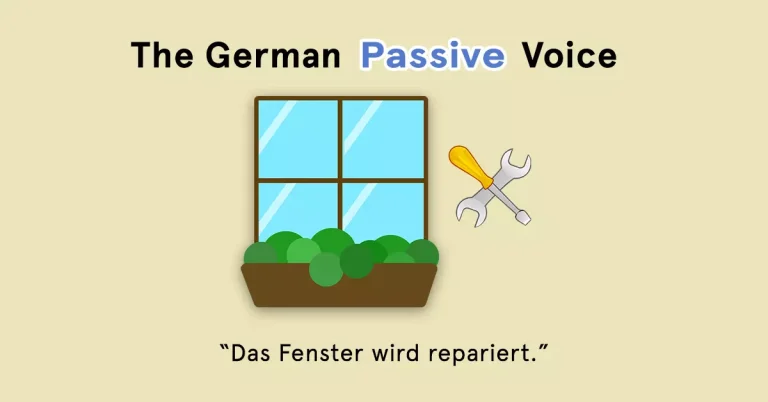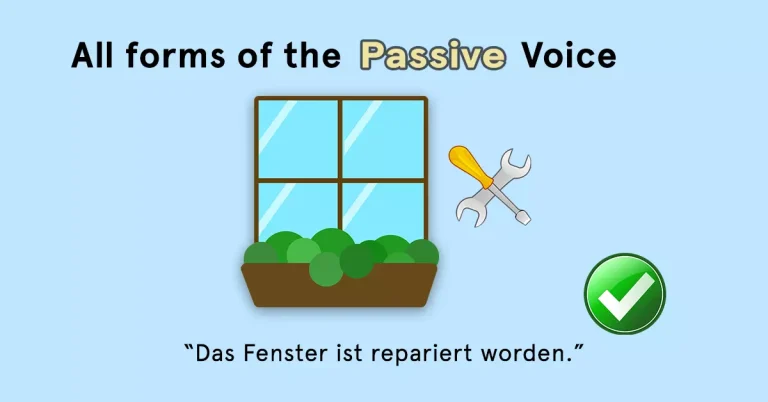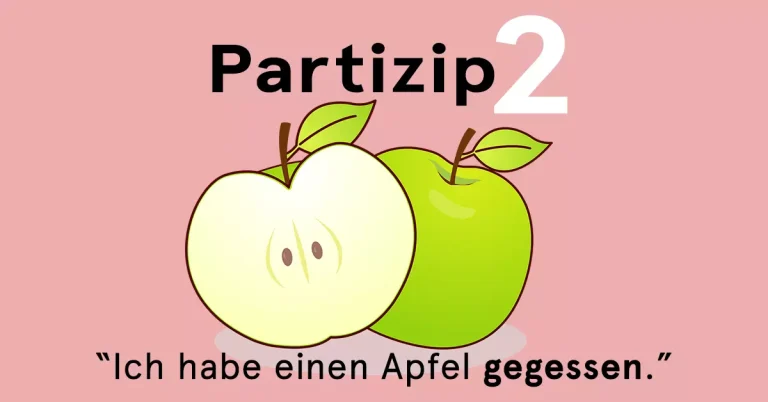With this article you will finally understand what the Zustandspassiv is as well as how and when to use it! I’ll show you exactly what the difference to the other passive forms (Handlungspassiv) is. It’s definitely a lot easier than you probably think. The main difficulty is that there is no direct equivalent in many languages.
If you need a reminder of what the passive voice is in the first place, check out this very basic article: Passive Voice In German (Part 1) – Quick Guide for Beginners!
Or check out this article where I show you all important tenses and forms of the far more common and far more important Handlungspassiv.
Forms of both passive types
Let’s start with the difference between the two types of passive voice in German: the Handlungspassiv (“passive of action”) which takes “werden” as its auxiliary. And then there is also the much less common Zustandspassiv (“passive of state”) which takes “sein” as its auxiliary.

Difference in meaning/focus
The main difference between the two passive forms is that the Zustandspassiv (unlike the Handlungspassiv) does not focus on the action, but on the result of an action. It focuses on the state that the action brought about – hence its name which translates to “passiv of state”.
Let’s take a look at these two German sentences:
Handlungspassiv:
(1) Das Fenster wird repariert.
The window is repaired (every now and then). / The window is being repaired (right now).
Zustandspassiv:
(2) Das Fenster ist repariert.
The window is repaired.
In English the two types of passive coincide (to be + past participle). So, unless something is ongoing right now (…is being repaired) you cannot even tell the difference by just looking at the forms. But if you look at the translations including the parentheses, you can tell that the translation of (1) is clearly about the action of repairing the window. In sentence (2) we are talking about the window being repaired now – about the state of it being repaired.
The same change in meaning/focus happens in the German sentences. So which one you are you supposed to use? As I stated in the introduction, the Handlungspassiv is a lot more common and therefore more important. But in many cases you can absolutely use either. The one thing that changes is the tense! More on this in the next section…
First action, then state!
Let’s stick with our examples with the window that is repaired now. If it’s repaired now, it means that clearly someone must have repaired it and therefore that it was repaired in the past.
So, let’s say some kids smashed your window with a football. After 2 long days your window finally gets repaired. You can say:
Handlungspassiv:
(3) Das Fenster wurde heute morgen repariert.
The window was repaired this morning.
or:
Zustandspassiv:
(4) Das Fenster ist jetzt repariert.
The window is repaired now.
So in many instances, you can choose the Zustandspassiv if you want to emphasise the new state. Or just use the Handlungspassiv emphasize the action.
But: Make sure you use the present tense for the Zustandspassiv and a past tense (Präteritum or Perfekt tense) for the Handlungspassiv. This applies to most scenarios, where just like in our example, you’re talking about a state now or an action in the past that caused that state.
More examples
These examples should make everything we’ve said so far even clearer. All of them will be in the following combinations again:
Zustandspassiv + Präsens or Handlungspassiv + Präteritum/Perfekt
(5) Der Mann wurde gestern bei einem Unfall verletzt.
The man was injured in an accident yesterday.
(6) Der Mann ist (jetzt) schwer verletzt.
The man is (now) seriously injured.
(7) Die Wand wurde gestern von meinem Onkel frisch gestrichen.
The wall was “freshly” painted yesterday by my uncle.
(8) Die Wand ist frisch gestrichen. Achtung! Nicht anfassen!
The wall is freshly painted. Attention! Do not touch!
(9) Das fehlende Ersatzteil wurde gestern bestellt.
The missing spare part was ordered yesterday.
(10) Das Teil ist bestellt. Wir hoffen, dass es nächste Woche kommt.
The part has been ordered. We hope it will arrive next week.
Zustandspassiv or adjective +”sein”?
Sometimes it’s hard to tell the difference between the Zustandspassiv and an adjective +”sein”.
(11) Das Geschäft ist geöffnet.
(12) Das Geschäft ist groß.
Take a look at sentence (11). Is this the Zustandspassiv (sein +Partizip 2) or is “geöffnet” here simply an adjective just like in sentence (12)? While (12) is definitely not the Zustandspassiv (“groß” is not a past participle form), example (11) could be interpreted as Zustandspassiv for all the reason discussed in this article thus far.
But if you look up the word geöffnet in the Duden, you will find that it’s classified as an adjective. So it’s basically an adjective (that derives from the verb “öffnen”, or rather from its past participle form) AND at the same time it’s also a past participle form. This happens with some past participles forms that are frequently used as adjectives and then get lexicalized in dictionaries as adjectives, rather than participle forms that are merely used like an adjective. As you can, this seems kind of confusing and the boundaries here seem somewhat arbitrary.
There is obviously more to this, linguistically speaking, but for you as a learner of German, it doesn’t matter what you call it as long as you use the right forms. No one in real life (probably not even in an exam) will ever ask you: “Was that Zustandspassiv or “sein” with an adjective what you just said??” 🙂
Recap
- For the Zustandspassiv you need: sein +Partizip 2
- It shifts the focus towards the state caused by the action of the verb.
- In many cases you have the choice between Handlungspassiv (past tense!) or Zustandspassiv (present tense!).
- In some cases it’s not easy/impossible to distinguish between Zustandspassiv or “sein” with an adjective. Don’t worry about it!
- Was the topic of Zustandspassiv something you’ve been struggling with?
- Do you have any further tips or explanations for fellow learners of German?
- Or maybe you have a question on the matter? Feel free to write a comment!



